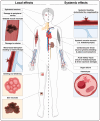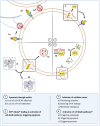Tissue damaging toxins in snake venoms: mechanisms of action, pathophysiology and treatment strategies
- PMID: 38519650
- PMCID: PMC10960010
- DOI: 10.1038/s42003-024-06019-6
Tissue damaging toxins in snake venoms: mechanisms of action, pathophysiology and treatment strategies
Abstract
Snakebite envenoming is an important public health issue responsible for mortality and severe morbidity. Where mortality is mainly caused by venom toxins that induce cardiovascular disturbances, neurotoxicity, and acute kidney injury, morbidity is caused by toxins that directly or indirectly destroy cells and degrade the extracellular matrix. These are referred to as 'tissue-damaging toxins' and have previously been classified in various ways, most of which are based on the tissues being affected (e.g., cardiotoxins, myotoxins). This categorisation, however, is primarily phenomenological and not mechanistic. In this review, we propose an alternative way of classifying cytotoxins based on their mechanistic effects rather than using a description that is organ- or tissue-based. The mechanisms of toxin-induced tissue damage and their clinical implications are discussed. This review contributes to our understanding of fundamental biological processes associated with snakebite envenoming, which may pave the way for a knowledge-based search for novel therapeutic options.
© 2024. The Author(s).
Conflict of interest statement
The authors declare no competing interests.
Figures





References
Publication types
MeSH terms
Substances
LinkOut - more resources
Full Text Sources

